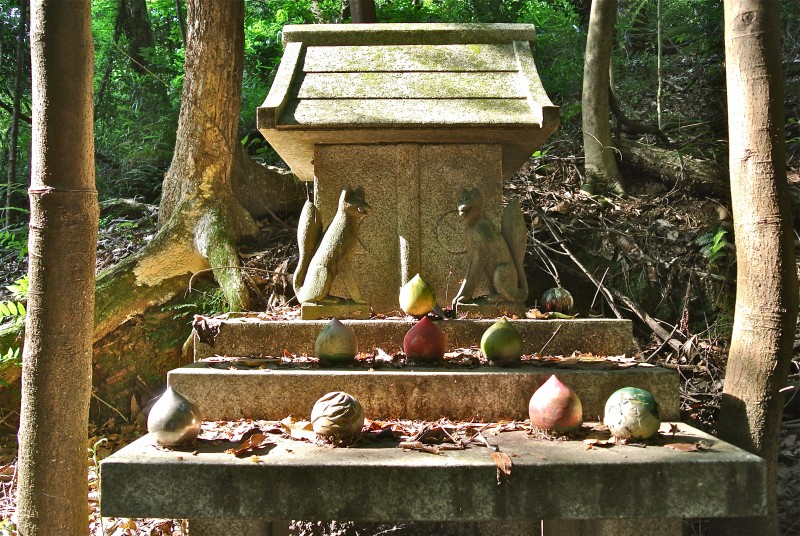
An Inari subshrine with ‘tama’ offerings that look relatively recent though the shrine is clearly untended
The first place I turned to in an attempt to get to the bottom of the Oiwa mystery was Fushimi Inari Shrine, since the Inari connection seemed so strong. However, one of the shrine staff assured us by telephone that there was absolutely no relationship with Oiwa Jinja.
The practice of putting up otsuka stone altars to Inari had started at Fushimi in Meiji times, he said, when people in trouble or ill health turned to ogamiyasan (mediums) who advised them on erecting otsuka with individualised names. No doubt the practice had spread to nearby Oiwa Jinja, he suggested. As for the present situation of the shrine, Fushimi Inari knew nothing and had no involvement.
So with the Fushimi connection proving fruitless, I determined to try the owner again. This time fortunately there was someone at home, and in response to my enquiry an elderly woman opened the door tentatively as we stood in the rain at the gate. For a few minutes it seemed she was going to dismiss us as she fended off our enquiries with polite but meaningless answers, but eventually she relented and invited us into the genkan (entrance area). For the next half an hour we were able to sit on the edge of the raised floor as she knelt before us and answered questions.
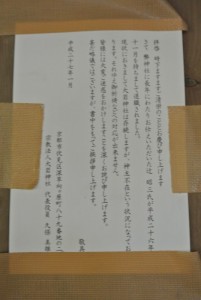
The small handwritten notice of abandonment
Information came in dribs and drabs, but a rather sad story emerged. She had married into the family, and her husband who had inherited the shrine had died unexpectedly at 50 without having told her much about it. The oldest son, who had been going to train as a priest, had also died. I got the impression that with the death of the son, the chance of saving the shrine had passed.
The youngest son, now married, lived with her but had his own career and no interest at all in the shrine. She herself seemed to have little interest in Shinto (at one point she could not remember the word for ‘the rope thing’ i.e. shimenawa), but had left everything up to the priest who had been in charge for the past forty years. Last year he reached the age of 85 or 86 and was no longer physically capable of running the shrine.
Because of the lack of income, the priest had only been part-time (I asked if the family had paid him; ‘a very small honorarium’, she replied). His main source of income had come from another job, and the priest’s son, an obvious candidate to take over the father’s job, had indeed become a priest but had taken the more financially secure route of working for Yasaka Jinja, where he was now one of the senior staff.
Before the war, Oiwa had apparently been a flourishing shrine with members from an Osaka fraternity visiting and donating. There had been too a tea room run by the priest’s wife for visitors. But things had changed after the war, with fewer visitors. Perhaps some of the believers had been killed, perhaps the new generation did not believe as their parents had, perhaps the Osaka fraternity had lost its charismatic leader.
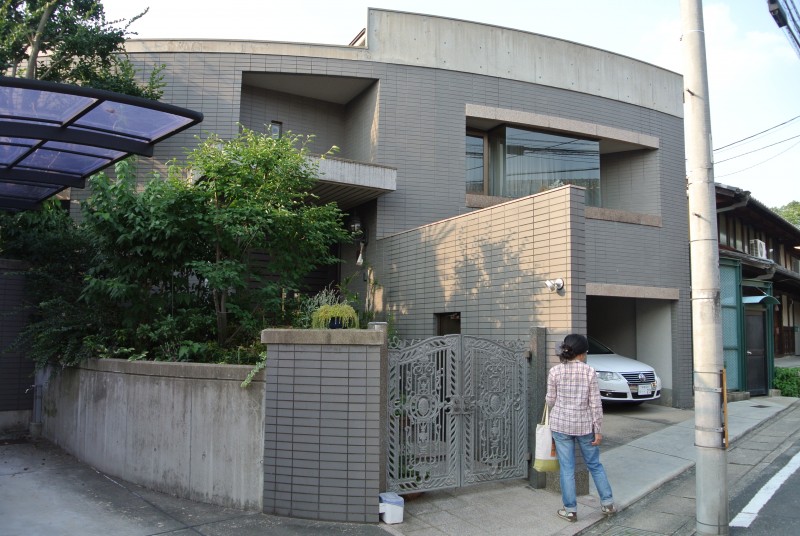
The house of the Oiwa Jinja owner, substantial by Japanese standards
With an elderly priest and falling patronage, Oiwa Jinja had been on the decline for years. The person who kept the misogi place clean had become old and stopped his caretaker duties. Others who helped out had died off too with no one to replace them. Financially too, the shrine had become a burden. When her husband died, there had been hefty inheritance taxes to pay. And when torii or stones started to fall over and be a danger to the public, her family had to pay for the repairs. The priest’s retirement appeared to have brought matters to a head.
I wondered what would happen to the shrine now? She didn’t know, she said, she was thinking about what to do. Kyoto city was not interested in conserving it. She might ask Jinja Honcho (Association of Shrines). How about a business sponsor I wondered, but she dismissed the idea as impossible. Perhaps she could sell it someone, I suggested? No, she said. Impossible. It was a family heritage. It had to be kept out of respect to the family’s ancestors.
She likened her position to the British aristocracy, saddled with debt and taxes but unwilling to give up the family estate. It seemed a good analogy. The aristocracy had to make compromises, living in a corner of their stately home and opening it to visitors. Perhaps she too would have to compromise in some way… but with no priest and a son who was uninterested, it was difficult to see an easy solution.
Perhaps there was land to sell off? Different parts of the mountain belonged to different people, she said. The bamboo forest for instance belonged to different people. Even the pond next to the lower portion of the shrine was not hers, and in fact there was a conservation group for it. Perhaps then that was a possible means of salvation – an Oiwa Jinja conservation group! It would of course take a good deal of initiative and good will to set up, requiring the energetic input of younger people. And there was little sign of that.
When it came to the history of the shrine, she said she knew nothing at all and advised asking the younger brother of her husband. He too said he knew nothing. So I was left to imagine what might have happened from the information I’d got so far. and my surmises were that after the Meiji Restoration a rich individual in the area of Oiwa Hill had decided to revive the local shrine. Perhaps he employed a priest called Tsuji, for the recently retired priest with that name was said to be the fourth generation.
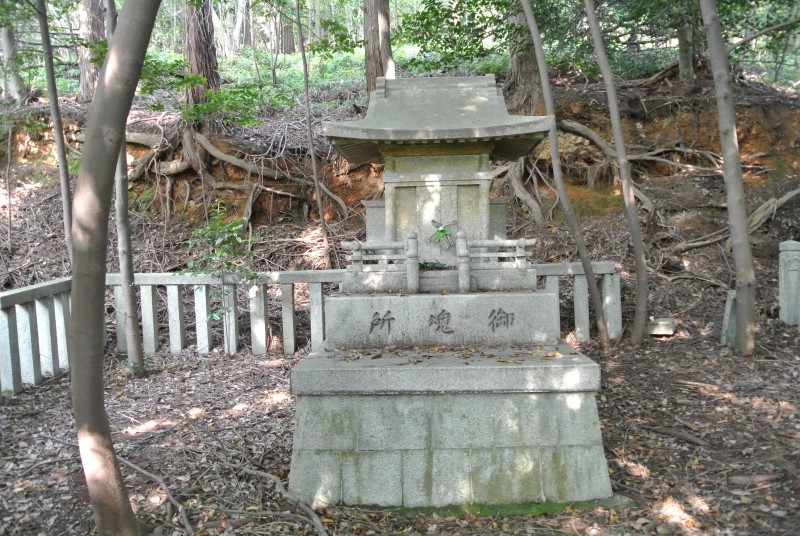
The goreisho is an area of thanks which honours the spirits of all those who worked on behalf of the shrine
The newly restored Oiwa Shrine must have won the favour of ogamiyasan living in the area, and through the recovery of someone with TB the shrine won the reputation of curing people with lung diseases. Perhaps it was one such person who in prewar years had started the fraternity in Osaka, as a result of which the shrine had seen a profusion of otsuka and Inari subshrines.
Now they stand forlorn and abandoned, but the sacred rocks remain as a poignant reminder of the numinous power of nature. Japan’s decreasing population in an age of secular values mean that such scenes are going to be increasingly common. It means the ‘land of the kami’ will have to face a time of falling numbers too as the Age of the Gods fades further into the past.
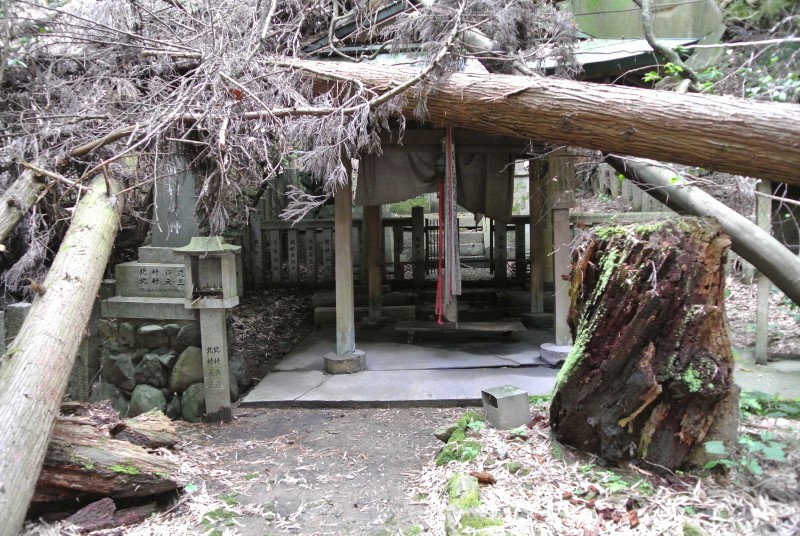
The abandoned shrine will need a lot of money and energy if it is ever to be restored

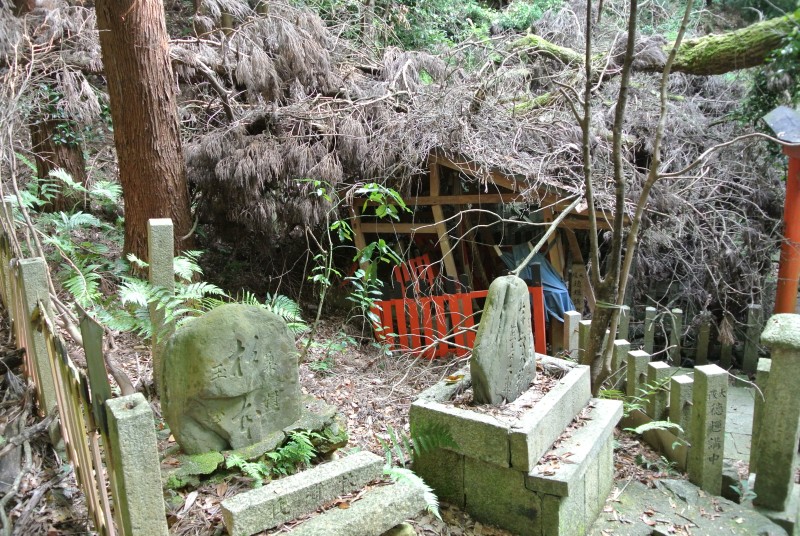
What a story, what a very sad story. What can be done to clean the shrine up? If there are any plans, please let me know. I would be a starter.
Thank you for your interest… It would need a lot of energy and commitment to build up a support group in order to save the shrine. If you were able to find a small group of energetic people with time to spare, then it could be a viable operation, though it would take a lot of organisation and of course it would need the goodwill of the owner…
I just wanted to add I have really enjoyed reading about your investigations in to this mysterious shrine. It is a wonderfully poignant story of heritage falling by the wayside and how so much that is special is preserved by the enthusiasm of individuals and thus easily lost, but you never know the attention you have bought to this place might be the first step towards a revival! My warm regards
Kind of you to write in with such thoughtful words… If I were much younger, I might have considered organising a clean-up brigade myself as the place is so special. Going to take an awful lot of work, though…
Wow, amazing to read this whole story after I accidentally found this shrine during a hike with a friend I met at Fushimi inari. We didn’t really plan to go there, but it was a beautiful trip after the extreme tourism at Fushimi inari. Unfortunately we didn’t spend much time to take a look at the Oiwa shrine itself, something I regret now after reading this story, but we ran a little out of time ’cause we wanted to reach the top of Oiwa hill before sunset.
What in my opinion was fascinating, is how nature is taking over what was created by humans. Ofcourse it would be great to clean up this place to the original situation, on the other hand, the history still seems a mystery, now the place is also mysterious…
(was the offered can of beer already there in June?)
Anyway, I’m curious about the future of Oiwa shrine and hope to visit this place again (and if a clean up will take place, I would love to help!!)
Thanks for the message, Gaby, and interesting to hear how you came across it by chance from Fushimi Inari. I presume you walked there along the Kyoto Trail? If so, how long did it take?
You are not the first to offer to take part in a clean-up operation. I’m tempted to go back to the owner this spring and see how she reacts to having ‘an international group’ help do some restoration work around the shrine. We could probably get a priest to do a ritual there before or afterwards too…
Thank you for providing me with this information, it seems to be the most comprehensive source on the Oiwa shrine! I stumbled across the shrine whilst walking the Kyoto Trail this week and was surprised to see such a special place fall into this condition. I am a Kyoto resident and would also be happy to help if a clean up operation happens. It would be a wonderful way to give back and learn more about this great country.
This is really interesting. I got my husband to do some research in Japanese and he found a site that said somebody was murdered there. (Sorry I didn`t ask the date) That might be something that would taint the area so maybe that is why people stopped going there and why people seemingly do not know much about it. Which seems odd coming from someone who has had the shrine in their family for generations.
Another thing he found is that women were forbidden from entering that shrine. This might explain why I felt a sense of not being welcome from just looking at the photos. But while I was reading your articles I did get a feeling that the local gods have lost that area to some negative entities. And you did have that photo with the being in black.
I dont know how reliable that site my husband found was but it might be worthwhile doing some reasearch in Japanese.
Thank you for that, it’s quite an intriguing extra dimension to the tale! Given the ownership by a woman, I didn’t have any feeling there was a taboo on women entering. No one I spoke to, including locals, ever mentioned it anyway…
Yes I did wonder if he was right on women not being allowed. Maybe it applied to the uninitiated or maybe just to some of the minor shrines.
Although from personal experience I have visited shrines and temples and in some parts sensed that I was not welcome. One place where I sensed this very strongly, is Okunoin on Kuramayama. The first time I entered the building a very large dark presence (the bouncer!) stood beside me and I felt very unwelcome. I have been to Kurama about 15 times and still don`t feel I am allowed to enter that one place whether it is because I am a woman, a foreigner or not ready I don`t know.
It is definately intriguing and very strange that people know so little about the place considering it had that famous sculptor make the torii.
Although I have gone in search of shrines before and have been close and local people I asked didn`t know! Maybe a lack of interest
I would be really interested to read more if you unearth any more information.
Maryann
Thank you for the input, Maryann. I’m surprised to read what you write about Kuramadera since the temple is headed by a nun. I had the privilege of hearing her speak a few years back, and she was very inspiring about the importance of living a life close to nature.